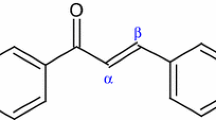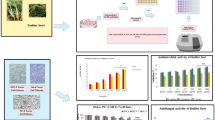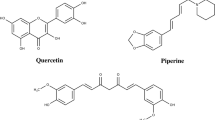Abstract
Infections by protozoans of the genus Leishmania are a major worldwide health problem, with high endemicity in developing countries. The drugs of choice for the treatment of leishmaniasis are the pentavalent antimonials, which show renal and cardiac toxicity. As part of a search for new drugs against leishmaniasis, we evaluated the in vitro leishmanicidal activity of the (−) mammea A/BB. The compound (−) mammea A/BB is a coumarin-type mammea purified from a dichloromethane crude extract of leaves of Calophyllum brasiliense Cambess (Clusiaceae). The isolated compound was characterized using spectral analyses by UV, infrared, nuclear magnetic resonance of 1H, 13C, distortionless enhancement by polarization transfer, correlation spectroscopy, heteronuclear multiple bond correlation, and heteronuclear multiple quantum coherence. The compound (−) mammea A/BB showed significant activity against promastigote and amastigote forms of L. amazonensis, with IC50 (50% inhibition concentration of cell growth) at a concentration of 3.0 and 0.88 μg/ml and IC90 (90% inhibition concentration of cell growth) of 5.0 and 2.3 μg/ml, respectively. The coumarin (−) mammea A/BB showed no cytotoxicity against J774G8 macrophages in culture, when it was tested at high concentrations that inhibited promastigote forms. Electron microscopy studies revealed considerable ultrastructural changes when promastigote forms of L. amazonensis were treated with 3.0 μg/ml of the coumarin (−) mammea A/BB for 72 h. We observed significant changes such as mitochondrial swelling with concentric membranes in the mitochondrial matrix and intense exocytic activity in the region of the flagellar pocket. Other alterations included the appearance of binucleate cells and multiple cytoplasmic vacuolization. These results showed that (−) mammea A/BB is a potent growth inhibitor of L. amazonensis and caused important changes in the parasite’s ultrastructure. This study provided new perspectives on the development of novel drugs with leishmanicidal activity obtained from natural products.


Similar content being viewed by others
References
Abe F, Nagafuji S, Okabe H, Akahane H, Estrada-Muñiz E, Huerta-Reyes M, Reyes-Chilpa R (2004) Trypanocidal constituents in plants. 3. Leaves of Garcinia intermedia and heartwood of Calophyllum brasiliense. Biol Pharm Bull 27:141–143
Araújo CAC, Alegrio LV, Leon LL (1998) Antileishmanial activity of compounds extracted and characterized from Centrolobium sclerophyllum. Phytochemistry 49:751–754
Berman JD (1997) Human leishmaniasis: clinical, diagnostic and chemotherapeutic developments in the last 10 years. Clin Infect Dis 24:684–703
Corrêa MP (1978) Calophyllum brasiliense. In: Dicionário das plantas úteis do Brasil e das Exóticas Cultivadas, vol. 3. 1st edn. Imprensa Nacional, Rio de Janeiro, p 388
Croft SL, Coombs GH (2003) Leishmaniasis—current chemotheraphy and recent advances in the seach for novel drugs. Trends Parasitol 19:502–508
Croft SL, Barrett MP, Urbina JA (2005) Chemotherapy of trypanosomiases and leishmaniasis. Trends Parasitol 21:508–512
Crombie L, Jones RCF, Palmer CJ (1987) Synthesis of the Mammea coumarins. Part 1. The coumarins of the Mammea A, B and C series. J Chem Soc 26:317–331
Da Silva KL, Dos Santos ARS, Mattos PEO, Yunes RA, Delle-Monache F, Cechinel-Filho V (2001) Chemical composition and analgesic activity of Calophyllum brasiliense leaves. Therapie 56:431–434
Delorenzi JC, Attias M, Gattass CR, Andrade M, Rezende C, Pinto AC, Henriques AT, Bou-Habib DC, Saraiva BEM (2001) Antileishmanial activity of indole alkaloid from Peschiera australis. Antimicrob Agents Chemother 45:1349–1354
Dharmaratne HRW, Tan GT, Marasinghe GPK, Pezzuto JM (2001) Inhibition of HIV-1 replication by Calophyllum coumarins and xanthones. Planta Med 68:86–87
Edzard E (1998) Harmless herbs? A review of the recent literarure. Am J Med 104:170–178
Ferreira ICP, Lonardoni MVC, Machado GMC, Leon LL, Gobbi Filho L, Pinto LHB, Oliveira AJB (2004) Anti-leishmanial acitivity of alkaloidal extract from Aspidosperma ramiflorum. Mem Inst Oswaldo Cruz 99:1–3
Gasparotto-Junior A, Brenzan MA, Ferreira ICP, Cortez DAG (2005) Estudo fitoquímico e avaliação da atividade moluscicida do Calophyllum brasiliense Camb (Clusiaceae). Quim Nova 28:575–578
Grevelink SA, Lerner EA (1996) Leishmaniasis. J Am Acad Dermatol 34:257–272
Guilet D, Séraphin D, Rondeau D, Richomme P, Bruneton J (2001) Cytotoxic coumarins from Calophyllum dispar. Phytochemistry 58:571–575
Ito C, Itoigawa M, Mishina Y, Cechinel-Filho V, Mukaianaka T, Tokuda H, Nishino H, Furukawa H (2002) Chemical constituents of Calophyllum brasiliensis: structure elucidation of seven new coumarins and their cancer chemopreventive activity. J Nat Prod 65:267–272
Ito C, Itoigawa M, Mishina Y, Cechinel-Filho V, Enjo F, Tokuda H, Nishino H, Furukawa H (2003) Chemical constituents of Calophyllum brasiliensis: structure of three new coumarins and cancer chemopreventive activity of 4-substituted coumarins. J Nat Prod 66:368–371
Kashman Y, Gustafson KR, Fuller RW, Cardellina JH, Mcmahon JB, Currens MJ, Buckheit RW, Hughes SH, Cragg GM, Boyd MR (1992) The calanolides, a novel HIV-inhibitory class of coumarin derivatives from the tropical rainforest tree, Calophyllum lanigerum. J Med Chem 35:2735–2743
Lorente SO, Rodriggues JCF, Jiménez CJ, Joyce-Menekse M, Rodrigues C, Croft SL, Yardley V, Luca-Frandley K, Ruiz-Pérez LM, Urbina J, Souza W, Pacanowska DG, Gilbert IH (2004) Novel azasterols as potential agents for treatment of leishmaniasis and trypanosomiasis. Antimicrob Agents Chemother 48:2937–2950
Mckee TC, Richard WF, Conni DC, Cardellina JH, Gulakowski RJ, Krepps BL, Mcmahon JB, Boyd MR (1996) New pyranocoumarins isolated from Calophyllum lanigerum and Calophyllum teysmannii. J Nat Prod 59:754–758
Morel C, Séraphin D, Teyrouz A, Larcher G, Bouchara JP, Litaudon M, Richomme P, Bruneton J (2002) New and antifungal xanthones from Calophyllum caledonicum. Planta Med 68:41–44
Patil AD, Freyer AJ, Eggleston DS, Haltiwanger RC, Bean MF, Taylor MJC, Breen AL, Bartus HR, Johnson RK, Hetzberg RP, Westley JW (1993) The inophyllums, novel inhibitors of HIV-1 reverse transcriptase isolated from the Malaysian tree, Calophyllum inophyllum Linn. J Med Chem 36:4131–4138
Rates SMK (2001) Plants as a source of drugs. Toxicon 39:603–613
Ravelonjato B, Libot F, Ramiandrasoa F, Kunesch N, Gayral P, Poisson J (1992) Molluscicidal constituents of Calophyllum from Madagascar: activity of some natural and synthetic neoflavonids and khellactones. Planta Med 58:51–55
Reyes-Chilpa R, Estrada-Muñiz E, Apan TR, Amekraz B, Aumelas A, Jankowski CK, Vázquez-Torres M (2004) Cytotoxic effects of mammea type coumarins from Calophyllum brasiliense. Life Sci 75:1635–1647
Rodrigues CO, Catisti R, Uyemura SA, Vercesi AE, Lira R, Rodrigues C, Urbina JÁ, Docampo R (2001) The sterol composition of Trypanosoma cruzi changes after growth in different culture media and results in the different sensitivity to digitonin permeabilization. J Eukaryot Microbiol 48:588–594
Rodrigues JCF, Attias M, Rodrigues C, Urbina JÁ, Souza W (2002) Ultrastructural and biochemical alterations induced by 22,26 azasterol, a Δ24(25)-sterol methyltransferase inhibitor, on promastigote and amastigote forms of Leishmania amazonensis. Antimicrob Agents Chemother 46:487–499
Rosa MSS, Mendonça-Filho RR, Bizzo HR, Rodriguez IA, Soares RMA, Souto-Padrón T, Alviano CS, Lopes AHCS (2003) Antileishmanial activity of a linalool-rich essential oil from Croton cajucara. Antimicrob Agents Chemother 47:1895–1901
Sartori NT, Canapelle D, De Sousa PT Jr, Martins DTO (1999) Gastroprotective effect from Calophyllum brasiliensis Camb. bark on experimental gastric lesions in rats and mice. J Ethnopharmacol 67:149–156
Stevens PF (1980) A revision of the Old World species of Calophyllum (Guttiferae). J Arnold Arbor 61:117–699
Takahashi M, Fuchino H, Satake M, Agatsuma Y, Sekita S (2004) In vitro screening of leishmanicidal activity in Myanmar timber extracts. Biol Pharm Bull 27:921–925
Tiuman TS, Ueda-Nakamura T, Cortez DAG, Dias Filho BP, Morgado-Díaz JÁ, Souza W, Nakamura CV (2005) Antileishmanial activity of pharthenolide, a sesquiterpene lactone isolated from Tanacetum parthenium. Antimicrob Agents Chemother 49:176–182
Torres-Santos EC, Moreira DL, Kaplan MAC, Meirelles MN, Rossi-Bergmann B (1999) Selective effect of 2′ , 6′ -dihydroxy-4′ -methoxychalcone isolated from Piper aduncum on Leishmania amazonensis. Antimicrob Agents Chemother 43:1234–1241
Ueda-Nakamura T, Attias M, De Souza W (2001) Megasome biogenesis in Leishmania amazonensis: a morphometric and cytochemical study. Parasitol Res 87:89–97
Ueda-Nakamura T, Mendonça-Filho RR, Morgado-Díaz JA, Maza PK, Dias Filho BP, Cortez DA, Alviano DS, Rosa MS, Lopes AHCS, Alviano CS, Nakamura CV (2006) Antileishmanial activity of eugenol-rich essential oil from Ocimum gratissimum. Parasitol Int 55:99–105
Vannier-Santos MA, Urbina JA, Martiny A, Neves A, Souza W (1995) Alterations induced by the antifungal compounds ketoconazole and terbinafine in Leishmania. J Eukaryot Microb 42:337–346
World Health Organization (2003a) Leishmaniasis: geographical distribution. In: WHO communicable diseases surveillance and response. WHO, Geneva. Online: http://www.who.int/emc/diseases/leish/leisgeo1.html. Accessed 14 April
World Health Organization (2003b) Leishmaniasis: the disease and its impact. In: WHO communicable diseases surveillance and response. WHO, Geneva. Online: http://www.who.int/emc/diseases/leish/leisdis1.html. Accessed 14 April
Yasunaka K, Abe F, Nagayama A, Okabe H, Lozada-Pérez L, López-Villafranco E, Muniz EE, Aguilar A, Reyes-Chilpa R (2005) Antibacterial activity of crude extracts from Mexican medicinal plats and purified coumarins and xanthones. J Ethnopharmacol 97:293–299
Zhai L, Blom J, Chen M, Christensen SB, Kharazmi A (1995) The antileishmanial agent lincochalcone A interferes with the function of parasite mitochondria. Antimicrob Agents Chemother 39:2742–2748
Author information
Authors and Affiliations
Corresponding author
Rights and permissions
About this article
Cite this article
Brenzan, M.A., Nakamura, C.V., Prado Dias Filho, B. et al. Antileishmanial activity of crude extract and coumarin from Calophyllum brasiliense leaves against Leishmania amazonensis . Parasitol Res 101, 715–722 (2007). https://doi.org/10.1007/s00436-007-0542-7
Received:
Accepted:
Published:
Issue Date:
DOI: https://doi.org/10.1007/s00436-007-0542-7




